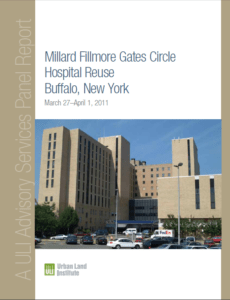Top Story
 Date: March 27 – April 1, 2011
Date: March 27 – April 1, 2011
Location: Buffalo, New York
Sponsors: Kaleida Health
Chair: Michael Beyard
Subject Area: Economic Growth and Development
The Panel’s Assignment
In 2007 the Commission on Health Care Facilities in the 21st Century, also known as the “Berger Commission,” a nonpartisan panel established to review New York state’s acute and long-term care systems, directed the orderly closure of the Millard Fillmore Gates Circle Hospital. Clinical services now provided at the hospital complex will move to new facilities under construction at the Buffalo-Niagara Medical Campus, located in downtown Buffalo. Millard Fillmore Gates Circle Hospital will remain open and fully functional through 2011; however, the scheduled move in 2012 will leave this facility without a health care–related user.
Kaleida Health requested the services of a ULI Advisory Services panel to help identify strategies consistent with market realities for the expeditious redevelopment of the Millard Fillmore Gates Circle Hospital complex in a way that fulfills Kaleida’s obligations to the community it serves. Kaleida Health has indicated that it does not wish to engage in redevelopment of the property’s more than 882,000 square feet itself because such work is outside Kaleida’s mission of delivering high-quality health care.
Deciding the future reuse of the Millard Fillmore Gates Circle Hospital is both an extraordinary responsibility and an opportunity for the board of Kaleida Health. Developing these areas will require vision, a communitywide will to see it happen, the commitment and persistence to follow through, and the imaginative use of public and private partnerships to finance and facilitate development.
Summary of Recommendations
Following an intense week of interviews, site tours, and discussion, the panel recognized significant opportunity for Kaleida Health to steer redevelopment of the site. The recommendations set forth here were formulated to create a large-scale, mixed-use redevelopment program appropriate within the context of the city, the neighborhoods surrounding the region, and the existing business climate.
These recommendations do not leave the city with a site that is rigidly locked into a single vision and plan, incapable of responding to the typically dynamic forces of population and job growth when viewed over a ten-year horizon. Summarized below, these recommendations are described in more detail later in this report:
- Hire a not-for-profit developer to manage redevelopment of the site. Transfer ownership to this developer and prepare operating agreements, performance timelines, and other predevelopment agreements to ensure that this approach is successful.
- Clean and partially clear the site so it is “shovel-ready.”
- Restore Olmsted’s vision at Gates Circle, and recognize that it represents both a physical and a collaborative coming together of market forces, along with the community vision.
- Create a large-scale, mixed-use redevelopment program that incorporates a variety of land use alternatives centered around residential.
- Identify public realm improvements organized around Gates Circle, which acts as the site’s central organizing feature; create high-quality open and community space interspersed throughout the development.
- Create a steering/advisory committee of high-level stakeholders to help guide the community engagement process.
- Be patient while being persistent.